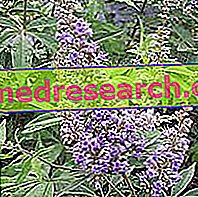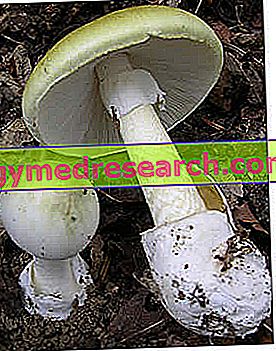By Dr. Rita Fabbri
The term Agnocasto derives from a Greek word that translated literally means "pure", hence the name "Agnus", to remember precisely the anaphrodisiac properties of this plant. Later the word "Castus" was also added, further emphasizing the meaning of purity.
Homer defines the Agnocasto as "tendril for braiding", this is the etymological meaning of the genus "Vitex".
The Greek doctor Dioscorides recommended the Agnocasto to decrease libido. Pliny the Elder in his "Naturalis Historia" writes that it was spread on the beds of Athenian women to ensure their loyalty when their husbands went to war.
Pietro Andrea Mattioli, Sienese physician and botanist of the sixteenth century, on the subject of the Agnocasto, writes in his figurative herbarium: "... forces the impulses of Venus so much eaten fried as raw ... it is believed that not only by eating or drinking the chaste men but still giacendovisi ... ".
The Agnocasto is also known with the name of "pepper of the monks" because the fruits have a spicy taste and the plant was cultivated by the monks in their gardens as an anaphrodisiac in order not to betray the vow of chastity.
Among the chemical constituents of the Agnocasto is a flavonoid, vitexin, which actually has relaxing properties. Agnocasto-based preparations are generally used in the treatment of disorders related to the menstrual cycle.
In the popular herbalist tradition, the Agnocasto was also used to stimulate lactation, but this effect has not yet been demonstrated.
 | Botanical name : Vitex agnus castus L. Family : Verbenaceae Parts used : Fruits |
Botanical description
The Agnocasto is a small tree or shrub, up to 5-6 meters high, originating from the Mediterranean. It has palmate-composed leaves with 5-7 leaflets, aromatic, dark green and white, tomentose in the lower part; the flowers are violet, tubular, gathered in long and thin spikes, bloom between June and September. Commonly the flowers of the Agnocasto are purple-lilac, sometimes white. The ideal climate is temperate and prefers fresh soil; however it adapts to any type of soil as long as it is not dry. It grows well both in full sun and in dim light. It is a spontaneous and garden plant. In Italy the Agnocasto grows on the banks of the rivers and in damp places. It can be used to embellish hedges. The fruits are black berries (5 mm) containing four seeds: extremely hard, aromatic smell, bitter and slightly pungent taste. The Agnocasto is not a particularly showy plant but it is very resistant.
Chemical composition
Diterpenes (eg rotundifuran, vitexilactone), iridoidoglycosides (eg aucubin, agnosias), flavonoids (eg casticin, vitexin), alkaloids (eg vaticin), essential oil (mainly composed of monoterpenes).
Therapeutic indications
The fruit of the Agnocasto acts on the endocrine system, in particular it modulates the production of some pituitary hormones. This justifies its use for treating irregularities in the menstrual cycle and reducing premenstrual symptoms.
The Agnocasto is useful in disorders related to the menstrual cycle, such as amenorrhea (absence of menstruation), mastalgia or mastodynia (breast pain), oligomenorrhea (condition in which the interval between cycles is less than 25 days), polymenorrhea (condition in where the distance between two successive menstruation exceeds 36 days). Agnocasto is also useful in premenstrual syndrome (PMS).
Preparations equivalent to 30-40 mg / day of drugs and up to 240 mg / day are used in women with PMS. A treatment of at least three months may be appropriate.
Menstrual cycle disorders and premenstrual syndrome are very frequently due to hyperprolactinemia associated with corpus luteum insufficiency. The adeno-hypophysial secretion of prolactin is inhibited by dopamine and stimulated by the hormone that releases thyrotropin (TRH), the latter released by the hypothalamus. The mechanism of action of the Agnocasto is not completely clarified, however the one considered more probable involves the interaction between the diterpene component of the Agnocasto with the dopaminergic receptor D2 located on the anterior pituitary. It appears that the Agnocasto acts as a selective agonist on the D2 dopaminergic receptor, thus inhibiting the release of prolactin (1). The concentration of the luteinizing hormone and the stimulating follicle hormone remains unchanged. It appears that some components of the Agnocasto (apigenin) can act on the α and β receptors of estrogen (2). Beta-endorphin receptors are also considered possible targets (3).
Numerous studies attest to the effectiveness of Agnocasto in PMS and in particular in mastodynia and in psychic and somatic disorders related to the syndrome. Here are just a few recent and particularly significant ones:
- In a randomized, double-blind (a) placebo-controlled study, 178 women with PMS were treated daily with 20 mg of a dry Agnocasto extract or placebo for three consecutive menstrual cycles. The improvement recorded by the patients' self-assessment of the six main symptoms of PMS (irritability, mood alteration, irritability, migraine, breast swelling, other menstrual symptoms including swelling) was significantly greater in the group treated with the Agnocasto. Even the evaluation of doctors showed a significant superiority of the group treated with the Agnocasto (4).
- In an open-label study (b), 34 women (aged between 18 and 43) suffering from hyperprolactinemia were treated with an Agnocasto extract corresponding to 40 mg of dry drug per day for a month. In 27 cases, prolactin levels have been significantly reduced (5).
- In a multicenter observational study (c), 1634 patients with PMS received two capsules a day, each containing 1.6-3.0 mg of an extract, corresponding to 20 mg of Agnocasto. After a three-cycle treatment period, 93% showed a decrease or cessation of disorders such as depression, anxiety, "craving" and overhydration. Eighty-five percent of doctors rated the overall clinical efficacy rating as good or very good and 81% of patients rated their post-treatment status as very satisfactory. The analysis of the frequency and intensity of mastodynia found that the disturbances still present after 3 months were less intense overall (6).
Contraindications, special warnings and appropriate precautions for use, undesirable effects
No known contraindications, no necessary warnings and no effects reported at the recommended doses. In patients receiving concomitant treatment with dopamine receptor antagonists, mutual attenuation of effects may occur. In the literature there are no data available regarding the use of this plant during pregnancy, therefore the Agnocasto should not be taken during gestation.
BIBLIOGRAPHICAL NOTES
- W.Wuttke et al., Vitex agnus castus: pharmacological and clinical indications, Phytomedicine 2003; 10: 348-357. " Dopaminergic compounds presented in Vitex agnus castus are clinically important compounds wich improve premenstrual mastodynia and possibly also other symptoms of the premestrual syndrome."
- H.Jarry et al., Evidence for estrogen receptor beta-selective activity of Vitex agnus castus and isolated flavones, Planta Med 2003; 69: 945-947.
- DE Webster et al., Activation of the mu-opiate receptor by Vitex agnus castus methanol extracts: implications for its use in PMS, J.Ethnopharmacol 2006; 106: 216-221.
- Schellenberg R. Treatment for the premenstrual syndrome with agnus castus fruit extract: prospective, randomized, placebo controlled study.BMJ 2001.322: 134-7
- Gorkow C. Klinischer Kenntnisstand von Agni-casti fructus. Klinisch-pharmakologische Untersuchungen und Wirksamkeitsbelege. Z.Phytotherapie 1999; 20: 159-68.
- Loch EG, Selle H, Boblix N. Treatment of premenstrual syndrome with a phytopharmaceutical formulation containing Vitex agnus castus . J.Women's Health Gender-Based Med 2009; 9.315-20.
(a) A randomized, double-blind study is defined as a clinical trial or an experimental evaluation on human beings where neither the patient nor the doctor knows the nature of the substance being administered. In the blind study, only the doctor knows the nature of the substance being administered.
(b) An open-label study is defined as a clinical study that does not have any specific methodological characteristics (it may be a clinical study without a control group or without masking).
(c) An observational study is defined as an analytical epidemiological study in which the researcher does not intervene but merely records (observes) what happens in reality; multicenter when it takes place in two or more centers with an identical protocol and a coordinator who is in charge of processing all the data and analyzing the results.



